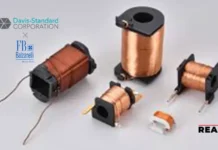Winbond Electronics Corporation, a leading global supplier of semiconductor memory solutions, announced the W25Q64NE, a 1.2V SpiFlash® NOR Flash IC in a 64Mb density which offers the large code storage capacity and active mode power savings needed by the latest generation of smart wearable and mobile devices.
Winbond was the first Flash memory manufacturer to introduce a 1.2V SPI NOR Flash device, which operates over an extended 1.14V-1.6V supply-voltage range for compatibility with a single alkaline AA battery cell’s output-voltage profile. By extending the 1.2V NOR Flash family to include a 64Mb part, Winbond addresses the requirements of smart devices with a larger code footprint. The new W25Q64NE is available for sampling and offer small package size like USON8-3×4 and WLCSP in industry-standard packages and pin-outs.
Product Features
The Winbond 1.2V parts reduce active mode power consumption by a third compared to equivalent 1.8V devices. Typically, 99% of total power consumption in mobile and wearable devices is in active mode, so using Winbond’s 1.2V NOR Flash parts, manufacturers of devices with a very small battery – such as True Wireless earbuds or fitness wristbands – can extend run-time between battery charges.
Winbond said: “Battery run-time has become a crucial differentiating factor in consumer purchase decisions for new product types such as wireless earbuds and smartwatches. This means that the new W25Q64NE gives manufacturers of these devices an instant way to add value to their products.”
In active Read mode at an operating frequency of 50MHz, a 1.8V SpiFlash part’s operating current of 4mA results in power consumption of 7.2mW. Operating at 1.2V and drawing the same Read mode current of 4mA at 50MHz, the W25Q64NE’s power consumption is just 4.8mW, providing an instant 33% power saving by replacing 1.8V flash.
Apart from power saving, a new system design also offers additional benefits. As the SoC process evolves to more advanced technology, the I/O voltage of new generation SoC is becoming lower than 1.8V and will require a level-shifter to connect to a traditional 1.8V/3V SPI Flash. This results in additional costs and adds to the complexity of the system design. By using a 1.2V Flash, the SoC can connect directly to the SPI Flash without a level shifter, reducing the BOM cost and PCB space. Overall, the benefits of 1.2V Flash can optimise the system design and cost.




